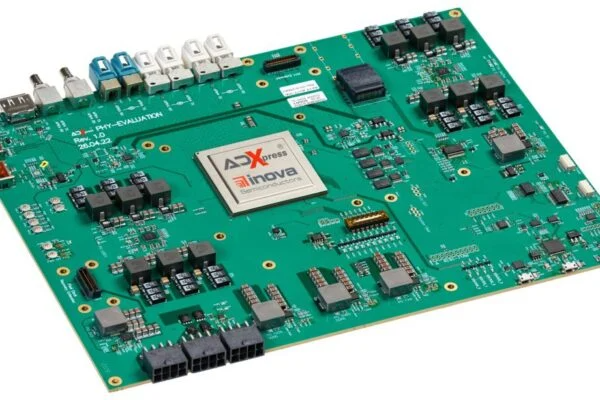The fabless semiconductor manufacturer Inova Semiconductors presents ADXpress, the Automotive Data Express, a novel, high-performance architecture that is intended to enable data transmission in the vehicle of tomorrow in a new dimension. According to the developers of the technology, ADXpress allows all raw sensor data to be transmitted via sensor-specific, virtual data paths with deterministic latency to one or more evaluation units. The sensors can be connected to an ADXpress node via PCI Express, Ethernet or SPI, whereby the data transfers currently take place electrically via a 30-GBit/s link. The data rate is essentially limited by the transmission medium. The physical layer is already prepared for optical media, with which 4 x 24 GBit/s can then be transmitted. Inova is not a newcomer in the field of data transmission in cars: the company, which is based in Munich (Germany), already has a strong market position with the Light and Sensor Network ISELED and with the APIX (Automotive Pixel Link) technology, which is tailor-made for use with vehicle displays.
The ADXpress technology bundles multiple different data paths on a serial 30 Gbit/s data link – just like APIX, the Automotive Pixel Link from Inova Semiconductors. In contrast to APIX, however, ADXpress is a universal mass data transport system that transmits any kind of data – whether pixel, Ethernet or sensor data from cameras, lidar and radar. With ADXpress, this opens up completely new possibilities in terms of network architecture and topologies: among other things, this allows new approaches to the implementation of today’s video interfaces, for example via PCI Express.
- ISELED – the LED goes digital
- In-car video link at 12 Gbps for high resolution
- ISELED alliance continues rapid growth
“With ADXpress, one can speak of a new dimension of connectivity in the vehicle, as the familiar point-to-point or point-to-repeater concepts can be replaced by more integrable and flexible topologies. This also opens up new possibilities around sensor data fusion for ADAS and AD. The number of displays that can be controlled and their maximum resolutions will continue to increase significantly,” explains Roland Neumann, CTO of Inova Semiconductors.
The ADXpress technology is based on virtual data paths, which are realised by transmitting data cells of constant size. All cells take the same path through the network. Unlike IP (Internet Protocol), where a packet can reach its destination via a different path than previous and subsequent packets, with ADXpress latency and jitter are constant on a virtual path. Virtual data paths based on data cells have the great advantage that multiplexing, repeating and duplicating on the layer processing the data cells can be done service-independently. Especially in multiplexing, it is possible to control the bandwidth allocation and the latency time of the individual data paths. The clou here is that the 128 virtual data paths of the ADXpress only “consume” bandwidth when user data is actually transmitted.
Generic “application adaptation units” implemented in hardware for burst and stream data enable ADXpress to package and unpackage continuous (radar, lidar, video) or burst-oriented data (PCI Express, Ethernet, SPI) in a uniform cell format “without software”. This allows burst and stream data to be combined with particularly low latency. This, in turn, allows simultaneous bundling of a large number of interfaces across several functional units – in any direction and with any input and output points – due to the bidirectional structure of ADXpress. These features enable universal network topologies that can be adapted to any conceivable interface.
The company plans to provide more information about the ADXpress concept at electronica 2022 in Munich. Hall B4, Stand 301.



Leave a comment